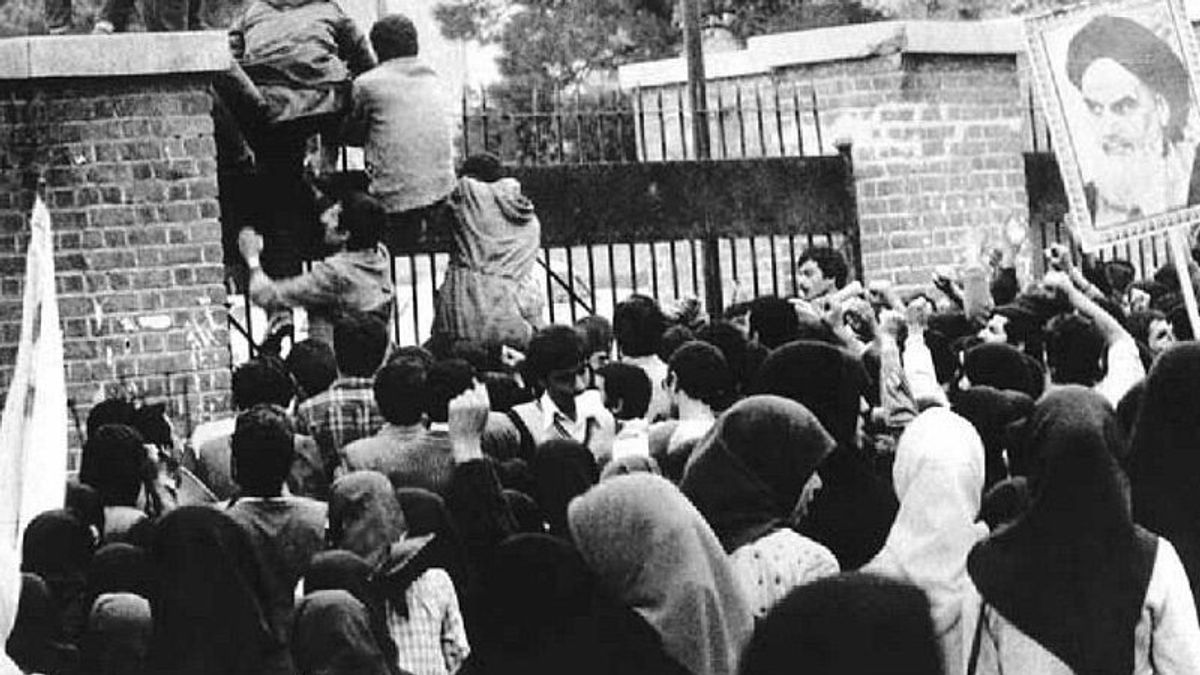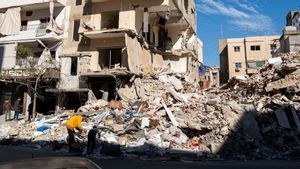JAKARTA - On November 4, 1979, a group of students supporting the Iranian Revolution stormed the United States (US) Embassy in Teheran, Iran. The student group took more than 60 Americans hostage. Some were even detained for 444 days.
One of the reasons for the attack was US President Jimmy Carter's decision to allow Mohammad Reza Pahlavi to go to the United States for cancer treatment. Mohammad Reza Pahlavi is the deposed Shah of Iran.
But the hostage-taking was more than just a matter of Mohammad Reza Pahlavi's medical care. The hostage-taking was a dramatic way for revolutionary students to claim that Iran had broken up with the past. The students also gave the message that the US must end its interference in Iranian affairs.
This hostage-taking was also their way of raising the intra and international profile of the Iranian Revolutionary leader and anti-American figure, Ayatollah Ruhollah Khomeini. The students released all of the hostages on January 21, 1981, 444 days after the hostages began and only minutes after US President Ronald Reagan gave his inauguration address.
Many historians believe that the Iran hostage crisis cost Jimmy Carter a second term as US President. To quote Britannica, when Mohammad Reza Pahlavi arrived in New York, a group of pro-Ayatollah students started breaking down gates and climbing the walls of the US embassy.

Once inside, they immediately took 66 people hostage. Most of them are diplomats and embassy employees. In a short time, 13 hostages were released. The hostages released were women, African-Americans, and nationals other than the US.
Moments later, the 14th hostage had health problems and was finally discharged. However 52 other hostages remain at the embassy compound. These are the ones who have had a long, hard day under the pressure of the hostages.
The US diplomatic maneuvers had no effect on Ayatollah's anti-American stance. Economic sanctions, such as confiscation of Iranian assets and trade embargoes do not make the hostages back down.

Meanwhile, although the hostages were never seriously injured, they were subjected to various kinds of degrading and terrifying treatment. The hostages were blindfolded and paraded before television cameras, and mocked in front of a crowd.
They are not allowed to speak or read. In fact, the hostages did not provide many opportunities for the hostages to change clothes.
Throughout the hostage crisis, the hostages have only terrifying uncertainty about their fate. The hostages never know whether they will be tortured, killed or released.
US military forces are involved to formulate a plan to rescue the hostages. However until April 1980, the US government still could not meet anyone to negotiate.
Despite the political upheaval in Iran, the hostages were still held by the original kidnappers at the embassy compound, until on April 24, 1980, a small US task force landed in the desert southeast of Tehran. Rescue started.
Rescue is problematicUnder the plan, a group of special operations soldiers would advance in helicopters to the second rally point, make raids on the embassy compound, and carry the hostages to the airstrip that the second squad of soldiers would secure in advance. The soldiers were planned to take the hostages away by air.
However, the operation was riddled with problems from the start. Two of the eight helicopters dispatched for the operation failed before arriving at the first preparation area.
Meanwhile, another helicopter broke down when he reached the location. Unable to complete the mission, US troops decided to withdraw. However, during the troop withdrawal process, one of the remaining helicopters collided with the rescue operation aircraft.
Eight US servicemen were killed. Their bodies are paraded in front of Iranian television cameras. The Carter administration is humiliated by a failed mission, which is even more damaging for the loss of life.
The US government then tried hard so that the bodies of the soldiers who died could be returned to the US. At the same time, US Secretary of State Cyrus Vance resigned in protest.
From the beginning, Cyrus had indeed stated that he did not agree with the mission. All diplomatic initiatives in the hostage crisis have stalled. The hostages were taken to a new hidden location without notice.
In May 1980, the US convinced its closest allies to carry out an economic embargo on Iran. But the embargo is not enough to weaken Iran.
In the midst of a hostage crisis, on July 27 to be precise, Mohammad Reza Pahlavi died. However, the deaths did not have any impact on the hostage problem.
The opportunity cameThe following two events following the death of Mohammad Reza Pahlavi make solving the crisis seem more likely. First, in mid-August 1980.
At that time Iran finally installed a new government. The Carter administration seized the opportunity by seeking to extend the diplomatic offer.

Second, on September 22, when Iraq invaded Iran. Although the ensuing Iran-Iraq war (1980-1988) distracted Iran from the short-term hostage negotiations, the embargo continued to weaken Iran's economy and the country's ability to deter Iraqi forces.
Likewise, when Iranian Prime Minister Mohammad Ali Rajaʾi visited the United Nations (UN) in October 1980. Many world leaders expressed the attitude that Iran would not receive support in the conflict with Iraq as long as they held hostage.
Rajaʾi insisted there would be no direct negotiations. Iran's reluctance to negotiate directly led Algeria to act as an intermediary during the negotiation process for releasing hostages.
The long impact of the hostage takingNegotiations continued throughout the late 1980s and early 1981s. During this time Iranian demands centered mostly on releasing frozen Iranian assets and lifting the trade embargo.
A deal was made. The hostages were released on January 20, 1981, minutes after the inauguration of the new US president, Ronald Reagan.
The Iran hostage crisis is a crushing blow to the US, both morally and prestige. This hostage-taking is a dark history for the US apart from the Vietnam War.
As well as creating a barrier on the path of US-Iran relations, the hostage-taking is widely believed to have contributed to Reagan's defeat of Jimmy Carter in the 1980 US presidential election.
In addition, in the years following the crisis, allegations emerged that Reagan's campaign team was blocking the Carter administration's efforts to negotiate with Iran. However, that presumption has been largely ignored.
The English, Chinese, Japanese, Arabic, and French versions are automatically generated by the AI. So there may still be inaccuracies in translating, please always see Indonesian as our main language. (system supported by DigitalSiber.id)













